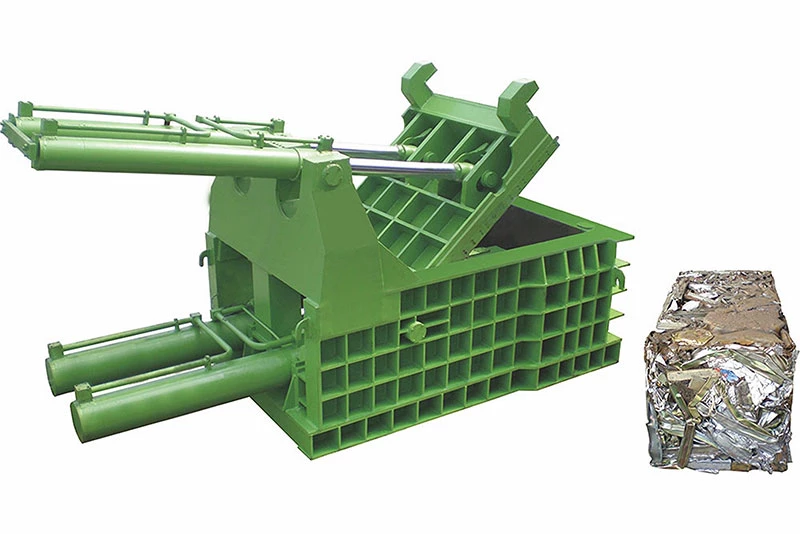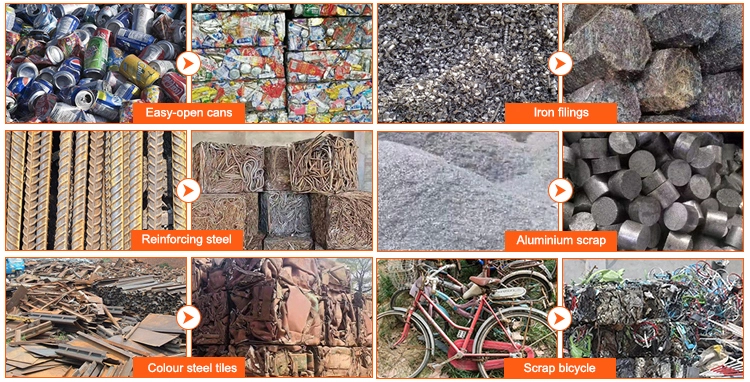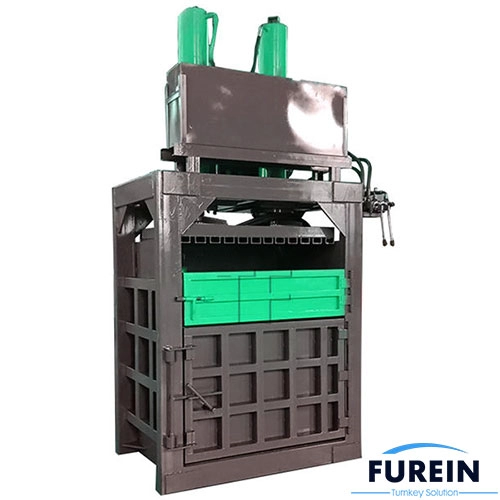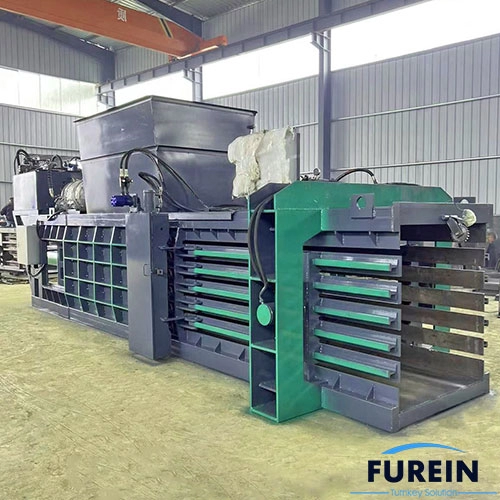hydraulic metal baler

- Hydraulic metal baler is a kind of recycling machinery, also known as a metal briquetting machine, has a wide range of styles and powerful functions, mainly used for the recycling of scrap metal, metal briquetting machine can squeeze a pile of scrap metal into different shapes, such as square, rectangle, octagonal body, cylinder and so on.
- The hydraulic cylinders on the machine provide pressure in the vertical direction, horizontal direction, and three lateral directions respectively.
- Multiple hydraulic cylinders work together to provide strong pressure. As materials enter and exit, the most troublesome scrap steel bars can be pressed into a square shape.
Metal materials that can be compressed
The hydraulic metal baler machine can press cans, paint buckets, tin cans, scrap iron, scrap steel, tin, bicycles, color steel tiles, light materials, scrap aluminum, scrap copper, car shells, car frames, metal edges, aluminum alloys, and other scrap metals into shape in one press.
The most common applications of hydraulic metal briquetting machines:
- Scrap Steel Briquetting: Compressing scrap steel into steel ingots.
- Aluminum scrap briquettes: compression of aluminum scrap into aluminum ingots.
- Copper scrap briquettes: compression of copper scrap into copper ingots.
As long as you need to be recycled, there is always a hydraulic metal machine that is suitable for you.

Parameters for hydraulic metal baler machine
| No. | Main Cylinder Pressure | Chamber size/mm | Bale size/mm | Bale weight about | Motor power | Operation mode |
|---|---|---|---|---|---|---|
| 1 | 125 tons | 1400*800*600 | 300*300*(300-600) | 50 kgs | 18.5kw | By manual /by PLC |
| 2 | 160 tons | 1600*1200*700 | 400*400*(600-900) | 100 kgs | 22kw*2 | |
| 3 | 200 tons | 1800*1500*800 | 500*500*(700-1200) | 250 kgs | 22kw*2 | |
| 4 | 250 tons | 2000*1750*1000 | 500*500*(800-1200) | 400 kgs | 30kw*2 | |
| 5 | 315 tons | 2500*2000*1000 | 500*500*(800-1500) | 1000 kgs | 30kw*2 | |
| 6 | 400 tons | 3000*2500*1200 | 600*600*(900-1500) | 1200 kgs | 37kw*2 | |
| 7 | 630 tons(for pressing car) | 3500*3000*1300 | 700*700*(900-1500) | 1500 kgs | 37kw*3 |
Here is the technical parameter table of the hydraulic metal briquetting machine, all the parameters here are for reference only, if there is any technical update, there will be no notice, if you want more detailed technical data, such as product detailed parameters, design drawings and so on, please contact us, Furein Machinery always here.
How to operate a hydraulic metal baler machine?
The working principle of hydraulic scrap metal baler is the equipment that compresses metal scrap into blocks with certain shapes and densities by applying high pressure. Its key parts are mainly:
- Frame: The frame structure that supports the whole machine, including chamber, hydraulic steel plate, base, etc.
- Hydraulic system: the main components to provide pressure, including hydraulic pumps, hydraulic cylinders, tanks, valves and so on.
- Mold: can determine the shape of scrap metal, such as square, rectangle, octagon, cylinder, etc..
- Control System: Used to control the pressure and stroke of the hydraulic system.
- Feed System: The device that feeds the metal scrap into the baler machine.
- Discharge system: to eject the baled metal block out of the chamber.
The working principle of the hydraulic scrap metal baler can be summarized as follows: Force = Pressure × Area. In the hydraulic metal baler machine, the pressure provided by the hydraulic cylinder is the force, the area of the briquetting surface is the area, and the degree of deformation of the scrap metal depends on the pressure applied and the nature of the metal scrap.
The specific working flow of the hydraulic scrap baling machine is as follows:
- Feed the scrap metal into the feeding system.
- A hydraulic pump is activated to transfer the hydraulic oil to the hydraulic cylinder.
- The hydraulic cylinder is pressurized to push the press head to press the metal scrap into the mold.
- Pressure is maintained for some time so that the metal scrap is fully formed.
- Release the pressure and open the cover.
- Start the discharging system to eject the baled metal block from the baler machine.
Features of hydraulic metal baler
- Hydraulic cylinder: with solid piston rod, strong top force.
- Extra cutter: easily cut all kinds of metal scraps.
- Operation mode: either independent operation lever, remote control, or PLC button control, it is simple and safe.
- Chamber: additional wear-resistant plate, long-lasting and durable.
- Cooling method: water-cooled, air-cooled or air-conditioned as you choose, environmentally adapted.
Explore 2 Alternative Favorites
For the recycling of waste metals, the following 2 models are also popular.
If you want to choose a hydraulic metal baler with low cost, small footprint and easy operation. It is recommended that you use the vertical model.
If there is a large amount of scrap metal, you want to feed it automatically, and you want to get large bales, a horizontal metal baler is an economical and practical choice. Equipped with an automatic plate chain conveyor, it is even more powerful.
How to install hydraulic metal baler machine?
The installation of hydraulic metal metal machine needs to be strictly by the operating instructions we provide to ensure the safety and stability of the equipment. Below are the general installation steps for metal baler machine:
Site preparation
- At your recycling site, a level, open area that can withstand the weight and vibration of the baler machine is required.
- Clean the site as necessary to remove obstacles.
- Concrete foundation work needs to be done on the ground if necessary.
Machine frame installation
- Transport the main machine part of the hydraulic metal baler machine (including the frame, hydraulic system, etc.) to the installation site.
- According to the foundation drawing, install the rack in the designated position.
- Use level meter to calibrate the level of the rack.
- Secure the rack floor bolts.
Hydraulic system installation
- Connect the hydraulic system correctly, connect hydraulic pipes, pumps, valves, cylinders and other components, and make sure that the connection is firm and without leakage.
- Install hydraulic valves and other hydraulic components.
- Connect the electrical control system.
Lubrication system check: Check and make sure the lubrication system is working properly and make sure all lubrication points are fully lubricated.
Safety Protection: Make sure all safety protection devices such as guards, emergency stop buttons, etc. have been properly installed and commissioned.
Test run
- Under no-load condition, test run the metal baler machine to check whether the functions of hydraulic system and control system are normal.
- Check whether the motion trajectory of the mold is correct.
- Adjust the pressure and stroke of the hydraulic system to make the metal baler reach the best working condition.
Training of operators: Provide operators with the necessary training to ensure that they understand how to operate the baler machine safely and correctly.
Maintenance: Carry out regular maintenance and servicing of the machine, following the maintenance manual provided by Furein Machinery.
What points do I need to pay attention to when installing?
- After the installation is completed, a comprehensive inspection and test run should be carried out to ensure that the equipment is safe and reliable.
- When installing the hydraulic oil pipe, attention should be paid to the cleanliness of the pipeline to avoid impurities into the oil system.
- When installing hydraulic valves and other hydraulic components, attention should be paid to sealing to prevent leakage.
- When installing the electrical control system, it should be carried out in strict accordance with the electrical specifications to ensure that the wiring is correct and firm.
- When installing the mold, attention should be paid to the positioning and fixing of the mold to ensure that the mold will not be shifted during the working process.
- During the test run, attention should be paid to observe the running condition of the baler, and find and remove the faults in time.


